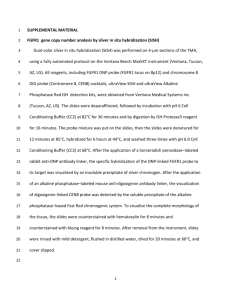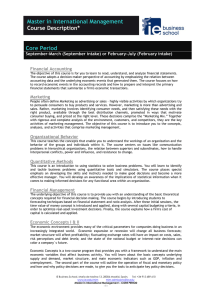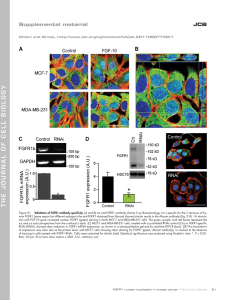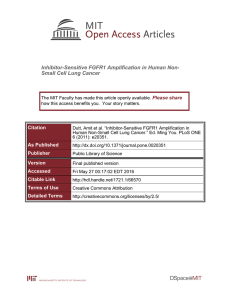FGFR1 peptide (806-821) ab45685 Product datasheet Overview Product name
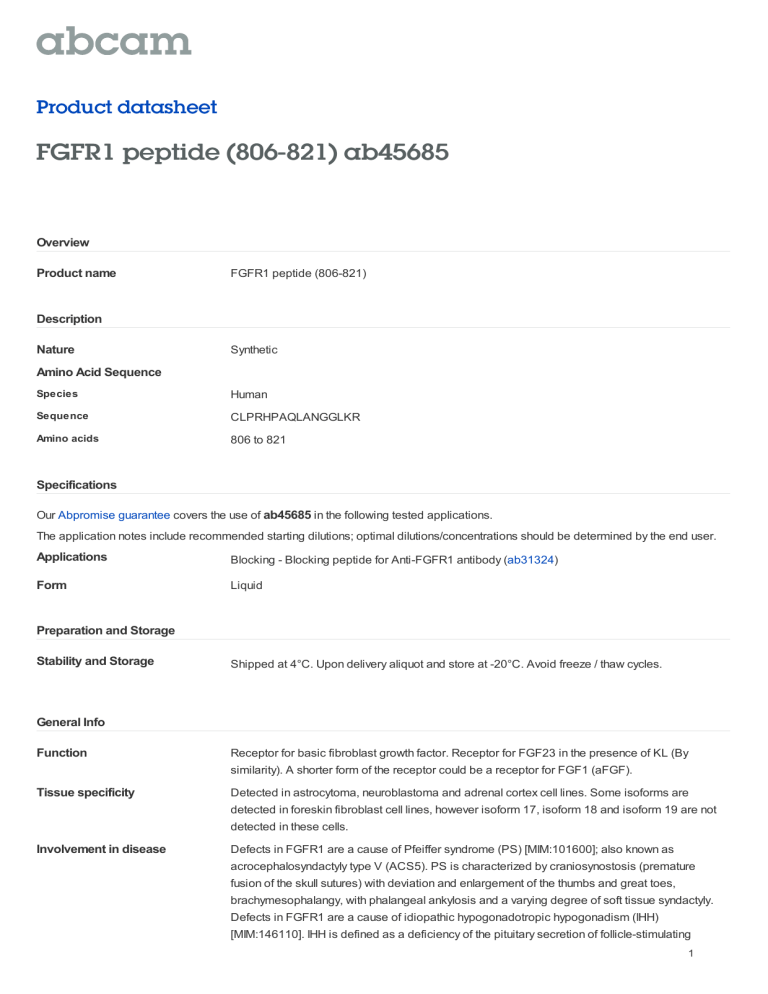
Overview
Product name
Description
Nature
Amino Acid Sequence
Species
Sequence
Amino acids
FGFR1 peptide (806-821)
Synthetic
Human
CLPRHPAQLANGGLKR
806 to 821
Specifications
Our Abpromise guarantee covers the use of
ab45685
in the following tested applications.
The application notes include recommended starting dilutions; optimal dilutions/concentrations should be determined by the end user.
Applications
Blocking - Blocking peptide for Anti-FGFR1 antibody ( ab31324 )
Form
Liquid
Preparation and Storage
Stability and Storage
Shipped at 4°C. Upon delivery aliquot and store at -20°C. Avoid freeze / thaw cycles.
General Info
Function
Tissue specificity
Involvement in disease
Receptor for basic fibroblast growth factor. Receptor for FGF23 in the presence of KL (By similarity). A shorter form of the receptor could be a receptor for FGF1 (aFGF).
Detected in astrocytoma, neuroblastoma and adrenal cortex cell lines. Some isoforms are detected in foreskin fibroblast cell lines, however isoform 17, isoform 18 and isoform 19 are not detected in these cells.
Defects in FGFR1 are a cause of Pfeiffer syndrome (PS) [MIM:101600]; also known as acrocephalosyndactyly type V (ACS5). PS is characterized by craniosynostosis (premature fusion of the skull sutures) with deviation and enlargement of the thumbs and great toes, brachymesophalangy, with phalangeal ankylosis and a varying degree of soft tissue syndactyly.
Defects in FGFR1 are a cause of idiopathic hypogonadotropic hypogonadism (IHH)
[MIM:146110]. IHH is defined as a deficiency of the pituitary secretion of follicle-stimulating
1
Sequence similarities
hormone and luteinizing hormone, which results in the impairment of pubertal maturation and of reproductive function.
Defects in FGFR1 are the cause of Kallmann syndrome type 2 (KAL2) [MIM:147950]; also known as hypogonadotropic hypogonadism and anosmia. Anosmia or hyposmia is related to the absence or hypoplasia of the olfactory bulbs and tracts. Hypogonadism is due to deficiency in gonadotropin-releasing hormone and probably results from a failure of embryonic migration of gonadotropin-releasing hormone-synthesizing neurons. In some cases, midline cranial anomalies (cleft lip/palate and imperfect fusion) are present and anosmia may be absent or inconspicuous.
Defects in FGFR1 are the cause of osteoglophonic dysplasia (OGD) [MIM:166250]; also known as osteoglophonic dwarfism. OGD is characterized by craniosynostosis, prominent supraorbital ridge, and depressed nasal bridge, as well as by rhizomelic dwarfism and nonossifying bone lesions. Inheritance is autosomal dominant.
Defects in FGFR1 are the cause of trigonocephaly non-syndromic (TRICEPH) [MIM:190440]; also known as metopic craniosynostosis. The term trigonocephaly describes the typical keelshaped deformation of the forehead resulting from premature fusion of the frontal suture.
Trigonocephaly may occur also as a part of a syndrome.
Note=A chromosomal aberration involving FGFR1 may be a cause of stem cell leukemia lymphoma syndrome (SCLL). Translocation t(8;13)(p11;q12) with ZMYM2. SCLL usually presents as lymphoblastic lymphoma in association with a myeloproliferative disorder, often accompanied by pronounced peripheral eosinophilia and/or prominent eosinophilic infiltrates in the affected bone marrow.
Note=A chromosomal aberration involving FGFR1 may be a cause of stem cell myeloproliferative disorder (MPD). Translocation t(6;8)(q27;p11) with FGFR1OP. Insertion ins(12;8)(p11;p11p22) with FGFR1OP2. MPD is characterized by myeloid hyperplasia, eosinophilia and T-cell or B-cell lymphoblastic lymphoma. In general it progresses to acute myeloid leukemia. The fusion proteins FGFR1OP2-FGFR1, FGFR1OP-FGFR1 or FGFR1-
FGFR1OP may exhibit constitutive kinase activity and be responsible for the transforming activity.
Note=A chromosomal aberration involving FGFR1 may be a cause of stem cell myeloproliferative disorder (MPD). Translocation t(8;9)(p12;q33) with CEP110. MPD is characterized by myeloid hyperplasia, eosinophilia and T-cell or B-cell lymphoblastic lymphoma.
In general it progresses to acute myeloid leukemia. The fusion protein CEP110-FGFR1 is found in the cytoplasm, exhibits constitutive kinase activity and may be responsible for the transforming activity.
Belongs to the protein kinase superfamily. Tyr protein kinase family. Fibroblast growth factor receptor subfamily.
Contains 3 Ig-like C2-type (immunoglobulin-like) domains.
Contains 1 protein kinase domain.
Binding of FGF1 and heparin promotes autophosphorylation on tyrosine residues and activation of the receptor.
Membrane. Nucleus. Cytoplasm. Cytoplasmic vesicle
Post-translational modifications
Cellular localization
Please note: All products are "FOR RESEARCH USE ONLY AND ARE NOT INTENDED FOR DIAGNOSTIC OR THERAPEUTIC USE"
Our Abpromise to you: Quality guaranteed and expert technical support
Replacement or refund for products not performing as stated on the datasheet
Valid for 12 months from date of delivery
Response to your inquiry within 24 hours
We provide support in Chinese, English, French, German, Japanese and Spanish
Extensive multi-media technical resources to help you
2
We investigate all quality concerns to ensure our products perform to the highest standards
If the product does not perform as described on this datasheet, we will offer a refund or replacement. For full details of the Abpromise, please visit http://www.abcam.com/abpromise or contact our technical team.
Terms and conditions
Guarantee only valid for products bought direct from Abcam or one of our authorized distributors
3
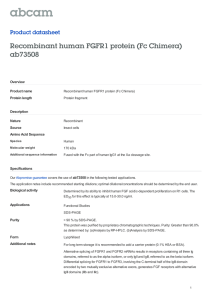
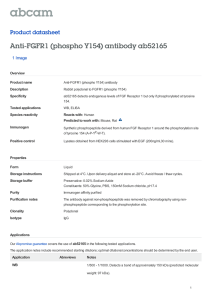
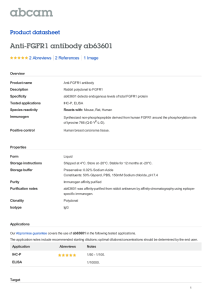
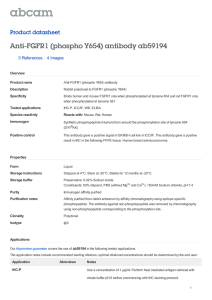
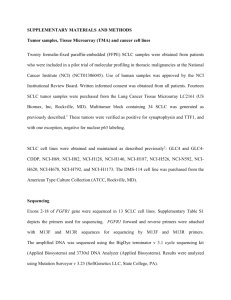
![Anti-FGFR1 alpha (phospho Y654) antibody [EP843(2)]](http://s2.studylib.net/store/data/012119363_1-1c5a5a18c421423246cd74c784ac1046-300x300.png)
